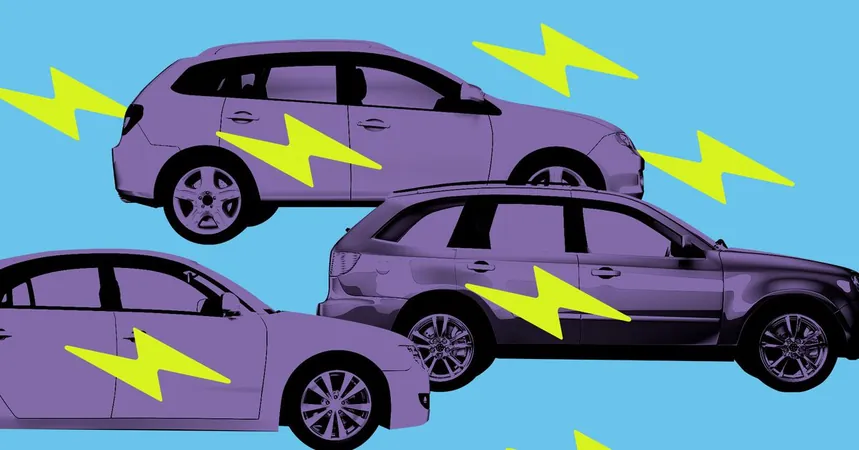
Trump’s Executive Order: A Major Step Back for Electric Vehicles and Environmental Protections?
2025-01-21
Author: Wei
Trump’s Executive Order: A Major Step Back for Electric Vehicles and Environmental Protections?
In a surprising move, former President Donald Trump has signed an executive order aimed at dismantling key electric vehicle (EV) policies established by the Biden administration. This initiative comes as part of a broader strategy to roll back environmental regulations, a clear signal of Trump’s return to office intentions that focus on traditional energy sources.
Labeling Biden’s policies as a “mandate”—a term that's misleading according to experts—Trump is positioning himself to promote fossil fuel interests over environmental protection. His actions include moving to weaken tailpipe emission standards, which could have alarming repercussions for air quality and climate change mitigation efforts.
What’s Inside Trump’s Executive Order?
The executive order, titled “Unleashing American Energy,” outlines several critical objectives:
1. **Dismantling the EV 'Mandate':** Trump has pledged to eliminate what he calls the “electric vehicle (EV) mandate” and replace it with policies that he claims will enhance consumer choice. He argues that government regulations have favored electric vehicles to the detriment of traditional gasoline-powered cars. However, many industry experts assert that there is no formal mandate as claimed; rather, initiatives were designed to incentivize EV adoption given the environmental crises we face.
2. **Halting EV Charging Infrastructure Funding:** The order directs federal agencies to stop the distribution of funds meant for EV charging infrastructure, derived from significant legislative efforts like the Inflation Reduction Act of 2022. This funding was critical for expanding the charging network necessary to support the growing number of electric vehicles on the road, which is essential for the success of EV adoption.
3. **Scrutinizing Regulatory Burdens:** The order also tasks agency heads with identifying regulations that Trump believes impose an “undue burden” on consumers, which predominantly points to emissions regulations. This could potentially enable more polluting vehicles to flood the market, jeopardizing the strides made in reducing the automotive carbon footprint.
Industry Impact and Consumer Preferences
Even as Trump initiates these reversals, the automotive landscape is evolving. Automakers have invested billions in electric vehicle technology, and consumer interest in environmentally friendly options remains robust. As of 2024, U.S. consumers purchased approximately 1.3 million EVs, marking a 7.3 percent increase from the previous year. Despite a slowdown in sales growth, EVs accounted for 8.1 percent of U.S. vehicle sales, showing a continuing trend towards cleaner transportation options.
Moreover, the implications of these policies extend beyond vehicles to a broader discussion on climate change. Burning fossil fuels generates significant greenhouse gas emissions—28 percent of U.S. emissions stem from transportation. Trump’s rollback of emission standards could lead to a more pronounced impact on climate change, worsening extreme weather patterns seen in recent years.
The Global Picture and Rare Earth Minerals
As part of his energy strategy, Trump is also highlighting the need for ramped-up mining efforts, particularly for non-fuel minerals, which are crucial for advanced technologies and green energy solutions, including electric vehicles. This focus on rare earth minerals draws attention to geopolitical interests, including past expressions of interest in Greenland due to its rich mineral deposits.
Looking Forward: A Divided Path
As the debate continues over the future of electric vehicles in America, Trump’s actions signal a contentious battle between traditional energy interests and the burgeoning need for sustainable practices. The consumer demand for electric vehicles and the growing awareness about climate change may stand in stark contrast to the administration's policies. The direction America takes concerning energy and vehicle policy remains a critical issue that could shape environmental and economic landscapes for years to come.
Stay tuned as we follow this evolving story—what will it mean for the future of our vehicles and our planet?



 Brasil (PT)
Brasil (PT)
 Canada (EN)
Canada (EN)
 Chile (ES)
Chile (ES)
 Česko (CS)
Česko (CS)
 대한민국 (KO)
대한민국 (KO)
 España (ES)
España (ES)
 France (FR)
France (FR)
 Hong Kong (EN)
Hong Kong (EN)
 Italia (IT)
Italia (IT)
 日本 (JA)
日本 (JA)
 Magyarország (HU)
Magyarország (HU)
 Norge (NO)
Norge (NO)
 Polska (PL)
Polska (PL)
 Schweiz (DE)
Schweiz (DE)
 Singapore (EN)
Singapore (EN)
 Sverige (SV)
Sverige (SV)
 Suomi (FI)
Suomi (FI)
 Türkiye (TR)
Türkiye (TR)
 الإمارات العربية المتحدة (AR)
الإمارات العربية المتحدة (AR)